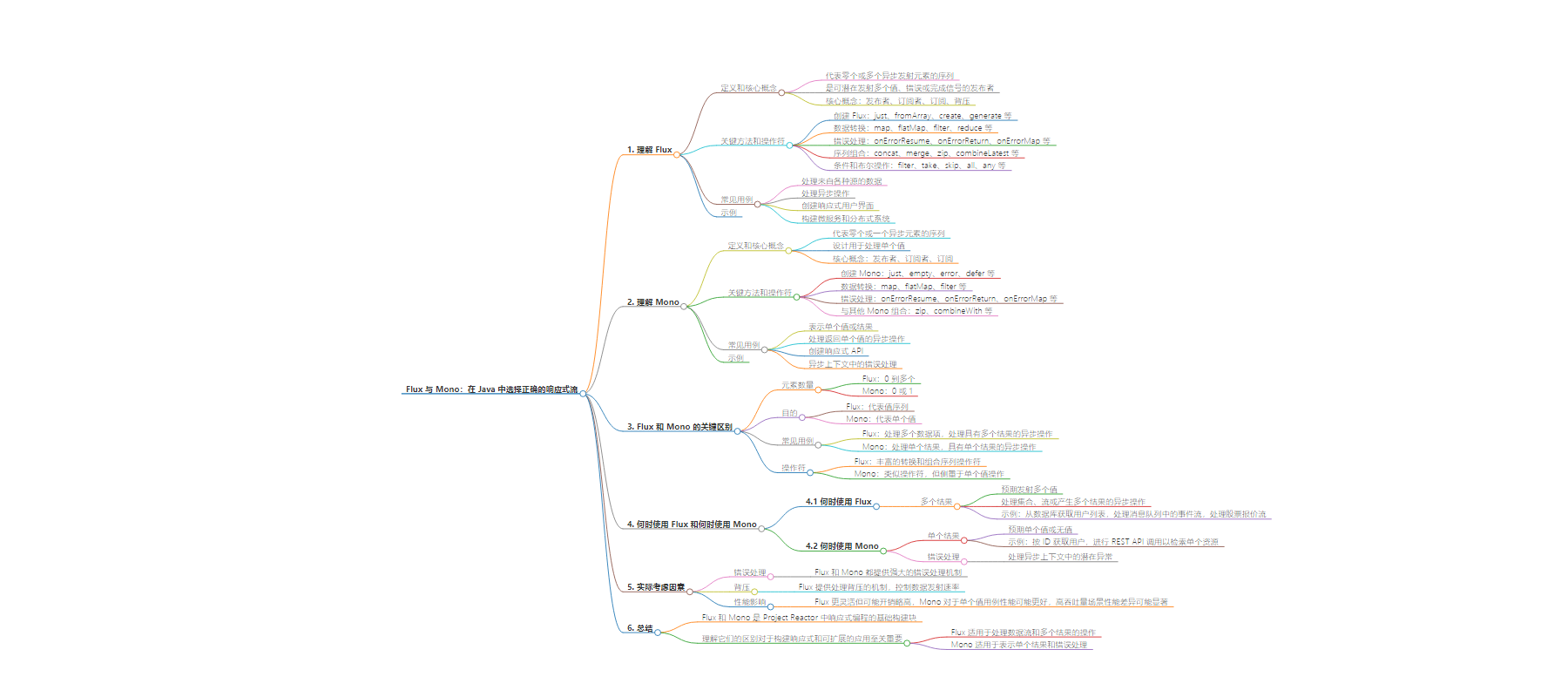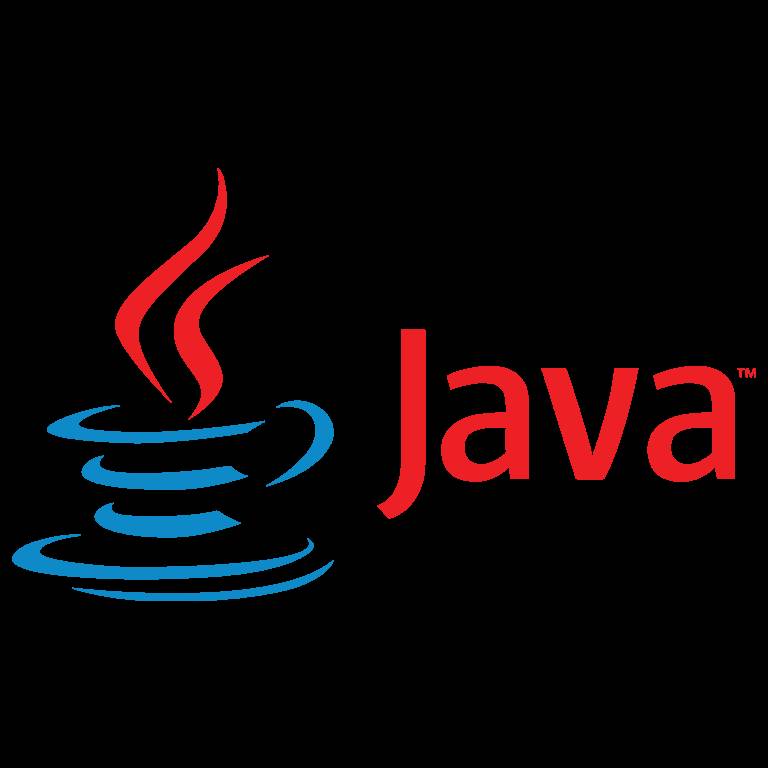包阅导读总结
1. 关键词:`Flux`、`Mono`、`Reactive Programming`、`Java`、`Asynchronous Streams`
2. 总结:
本文介绍了 Java 中 Project Reactor 的 Flux 和 Mono,对比了它们的定义、核心概念、方法、操作符、使用场景和关键差异,还阐述了选择时的实用考虑,包括错误处理、背压和性能影响,强调理解二者区别对构建响应式和可扩展应用的重要性。
3. 主要内容:
– Flux
– 定义和核心概念:表示零个或多个异步发射元素的序列。
– 核心概念:包括发布者、订阅者和订阅。
– 关键方法和操作符:如创建、转换、错误处理、组合等。
– 常见用例:处理多源数据、异步操作等。
– 示例:创建、转换和订阅 Flux 流。
– Mono
– 定义和核心概念:表示零个或一个异步元素的序列。
– 核心概念:类似 Flux。
– 关键方法和操作符:针对单个值操作。
– 常见用例:代表单个值或结果等。
– 示例:创建和订阅 Mono。
– 关键差异
– 元素数量:Flux 为 0 到多个,Mono 为 0 或 1 个。
– 目的:Flux 处理值序列,Mono 处理单个值。
– 常见用例:不同。
– 操作符:Flux 更丰富,Mono 侧重单值。
– 使用场景
– Flux 适用:多个结果、流数据等。
– Mono 适用:单个结果、错误处理等。
– 实用考虑
– 错误处理:两者都有机制。
– 背压:Flux 提供处理机制。
– 性能影响:简单单值场景 Mono 可能更好。
思维导图:
文章地址:https://www.javacodegeeks.com/2024/08/flux-vs-mono-choosing-the-right-reactive-stream-in-java.html
文章来源:javacodegeeks.com
作者:Eleftheria Drosopoulou
发布时间:2024/8/7 13:12
语言:英文
总字数:1086字
预计阅读时间:5分钟
评分:85分
标签:响应式编程,Java,Flux,Mono,Project Reactor
以下为原文内容
本内容来源于用户推荐转载,旨在分享知识与观点,如有侵权请联系删除 联系邮箱 media@ilingban.com
Reactive programming has emerged as a powerful paradigm for building scalable and responsive applications. At the heart of this paradigm in Java are Flux and Mono, two fundamental building blocks provided by Project Reactor. While both represent asynchronous streams of data, they serve distinct purposes.
This article will delve into the key differences between Flux and Mono, explore their use cases, and guide you in making the right choice for your reactive applications.

1. Understanding Flux
Definition and Core Concepts
Flux represents a sequence of zero or more asynchronously emitted elements. It’s a publisher that can potentially emit multiple values, errors, or completion signals. Think of it as a stream of data that can be processed, transformed, and consumed over time.
Core Concepts:
- Publisher: The source of data.
- Subscriber: The consumer of data.
- Subscription: The link between a publisher and a subscriber.
- Backpressure: The mechanism to control the rate of data emission.
Key Methods and Operators
Flux provides a rich set of methods and operators for manipulating and transforming data streams:
- Creating Flux:
just,fromArray,create,generate, etc. - Transforming data:
map,flatMap,filter,reduce, etc. - Error handling:
onErrorResume,onErrorReturn,onErrorMap, etc. - Combining sequences:
concat,merge,zip,combineLatest, etc. - Conditional and Boolean operations:
filter,take,skip,all,any, etc.
Common Use Cases
- Processing data from various sources (e.g., databases, APIs, file systems)
- Handling asynchronous operations (e.g., network requests, database queries)
- Creating reactive user interfaces
- Building microservices and distributed systems
Examples
// Creating a Flux from a list of numbersFlux<Integer> numbers = Flux.just(1, 2, 3, 4, 5);// Filtering even numbersFlux<Integer> evenNumbers = numbers.filter(n -> n % 2 == 0);// Mapping numbers to their squaresFlux<Integer> squaredNumbers = evenNumbers.map(n -> n * n);// Subscribing to the Flux to consume the datasquaredNumbers.subscribe(System.out::println);
This example demonstrates how to create a Flux, apply transformations, and subscribe to the resulting stream to print the squared even numbers.
2. Understanding Mono
Definition and Core Concepts
Mono represents an asynchronous sequence of zero or one element. It’s designed to handle single values, potentially with an error or completion signal. Think of it as a container for a single result, which might be available immediately or in the future.
Core Concepts:
- Publisher: The source of the single value.
- Subscriber: The consumer of the value.
- Subscription: The link between the publisher and the subscriber.
Key Methods and Operators
Mono provides methods and operators for working with single values:
- Creating Mono:
just,empty,error,defer, etc. - Transforming data:
map,flatMap,filter, etc. - Error handling:
onErrorResume,onErrorReturn,onErrorMap, etc. - Combining with other Monos:
zip,combineWith, etc.
Common Use Cases
- Representing single values or results
- Handling asynchronous operations that return a single value
- Creating reactive APIs
- Error handling in asynchronous contexts
Examples
// Creating a Mono with a single valueMono<String> message = Mono.just("Hello, world!");// Subscribing to the Mono to consume the valuemessage.subscribe(System.out::println);
This example demonstrates how to create a Mono with a single value and subscribe to it to print the message.
3. Key Differences Between Flux and Mono
Flux and Mono, while both representing asynchronous streams of data in Project Reactor, have distinct characteristics and use cases. The following table summarizes the key differences:
| Feature | Flux | Mono |
|---|---|---|
| Number of elements | 0 to N | 0 or 1 |
| Purpose | Represents a sequence of values | Represents a single value |
| Common use cases | Processing multiple data items, handling asynchronous operations with multiple results | Handling single results, asynchronous operations with a single outcome |
| Operators | Rich set of operators for transforming and combining sequences | Similar operators, but focused on single value manipulations |
By understanding these differences, you can effectively choose the appropriate reactive type for your specific use case.
4. When to Use Flux and When to Use Mono
4.1 When to Use Flux
- Multiple Results: When you expect multiple values to be emitted, Flux is the appropriate choice. This is common in scenarios involving collections, streams, or asynchronous operations that produce multiple results.
- Example: Fetching a list of users from a database:
Flux<User> users = userRepository.findAll();
- Example: Processing a stream of events from a message queue:
Flux<Message> messages = messageConsumer.receive();
- Streaming Data: Flux is ideal for handling streaming data, where elements are produced continuously. This is often used in real-time applications or data pipelines.
- Example: Processing a stream of stock quotes:
Flux<StockQuote> quotes = stockService.getQuotes();
4.2 When to Use Mono
- Single Result: When you expect a single value or no value at all, Mono is the preferred choice. This is common in scenarios involving asynchronous operations that return a single result or might not return anything.
- Example: Fetching a user by ID:
Mono<User> user = userRepository.findById(userId);
Example: Making a REST API call to retrieve a single resource:
Mono<Product> product = webClient.get() .uri("/products/{id}", productId) .retrieve() .bodyToMono(Product.class);
- Error Handling: Mono is often used for error handling in asynchronous contexts, providing a clear way to handle potential exceptions.
- Example: Handling potential exceptions when fetching a user:
Mono<User> user = userRepository.findById(userId) .onErrorResume(UserNotFoundException.class, exception -> Mono.empty());
By carefully considering the expected outcome of your asynchronous operations, you can effectively choose between Flux and Mono to build robust and reactive applications.
5. Practical Considerations
Error Handling
Both Flux and Mono offer robust error handling mechanisms. Operators like onErrorResume, onErrorReturn, and onErrorMap allow you to gracefully handle exceptions that occur during the processing of data streams. It’s essential to consider how errors should be propagated or recovered from in your application.
Backpressure
Backpressure is a crucial concept in reactive programming, especially when dealing with high-throughput systems. Flux provides mechanisms to handle backpressure, allowing you to control the rate at which data is emitted. By understanding and implementing backpressure strategies, you can prevent resource exhaustion and improve the overall performance of your application.
Performance Implications
The choice between Flux and Mono can impact performance. While Flux is generally more flexible for handling multiple values, it might incur slightly higher overhead compared to Mono. For simple use cases with a single value, Mono can offer better performance. However, the performance difference is often negligible unless you’re dealing with extremely high-throughput scenarios.
6. Wrapping up
Flux and Mono are fundamental building blocks in the reactive programming paradigm offered by Project Reactor. Understanding their distinctions is crucial for effectively building responsive and scalable applications.
Flux, capable of emitting multiple values, is ideal for handling data streams, processing collections, and managing asynchronous operations with multiple results. On the other hand, Mono, designed for zero or one value, excels in representing single results, error handling, and asynchronous operations with a single outcome.
